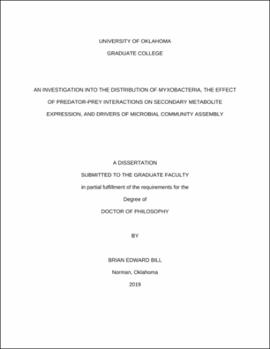| dc.description.abstract | The myxobacteria are Deltaproteobacteria capable of growing on a wide range of bacterial and fungal prey. To kill their prey, myxobacteria produce diverse secondary metabolites, many of which have medically desirable activities, including anti-viral, anti-fungal, anti-cancer, and antibacterial properties; however, the myxobacteria are difficult to cultivate because they do not form readily identifiable colonies on agar, do not disperse well in liquid, and grow slowly. As a consequence, the myxobacteria are poorly represented in culture, and as such their natural distribution and the effect predator-prey interactions on secondary metabolite expression are poorly understood. The purpose of the first part of this dissertation is to expand our knowledge of the natural distribution of the myxobacteria using cultivation-independent techniques, study the effect of predator-prey interactions on secondary metabolite expression, and improve their cultivation by supplementing growth media inhibitory dyes. The natural distribution of the myxobacteria was described using cultivation independent techniques. This analysis identified terrestrial, halophillic/halotolerant, and generalist families of myxobacteria, highlighted the limitations of cultivation-based biogeography, and provided insights into the ecology of both cultivated and uncultivated clades of myxobacteria. To test the effect of predator-prey interactions on secondary metabolite production, cultures of Myxococcus fulvus were grown on media containing heat-killed prey biomass as the sole carbon and energy source. Myxococcus fulvus produced more diverse LC-MS profiles when growing on prey that supported better growth, suggesting a link between predation rates and secondary metabolite expression. Finally, we report that a concentration of 1 mg/L crystal violet in standard growth media is useful for the isolation and purification of myxobacteria. Applied correctly, the insights from this dissertation will both improve cultivation of novel myxobacteria by directing sample site selection, and help unlock products of silent secondary metabolite gene clusters in existing cultures by leveraging the effects of predator-prey interactions.
The second half of this dissertation focuses on the effect of chemical and biological forces on bacterial diversity and community structure. In the last 50 years, world wide application of NPK fertilizers has increased ~500%, and the widespread use of fertilizers in agriculture has indirectly increased the input of inorganic nutrients into natural ecosystems. Because microbial communities are sensitive to changes in nitrogen, phosphorus, and potassium, we hypothesized that nutrient enrichment would suppress diversity and alter the structure of leaf litter bacterial communities by selecting for copiotrophic taxa. We demonstrated that bacterial communities in tropical rainforest leaf litter are more sensitive to changes in nitrogen compared to potassium, phosphorus, or micronutrients. In addition to chemical factors, macrobiotic plant-animal interactions may also shape the diversity and structure of bacterial communities. The Portal Project is a long-term rodent exclusion experiment and has shown that the exclusion of the kangaroo rat (Dipodomys spp.) alters the density, diversity, and composition of the plant community through removal of granivory and soil disturbing behaviors; however, it was unknown if kangaroo rat removal has an effect on the soil microbial community. We hypothesized that granivorous rodent populations indirectly impact the diversity and structure of the bacterial community through regulation of the plant community. To test our hypothesis, we conducted a survey of soil bacterial communities, plant and rodent censuses, and soil chemistry analyses on rodent exclusion plots. Although the effect sizes were small, our results support the hypothesis that the direct and indirect effects of trophic interactions between above-ground populations can shape the diversity and structure of the below-ground bacterial community. | en_US |

